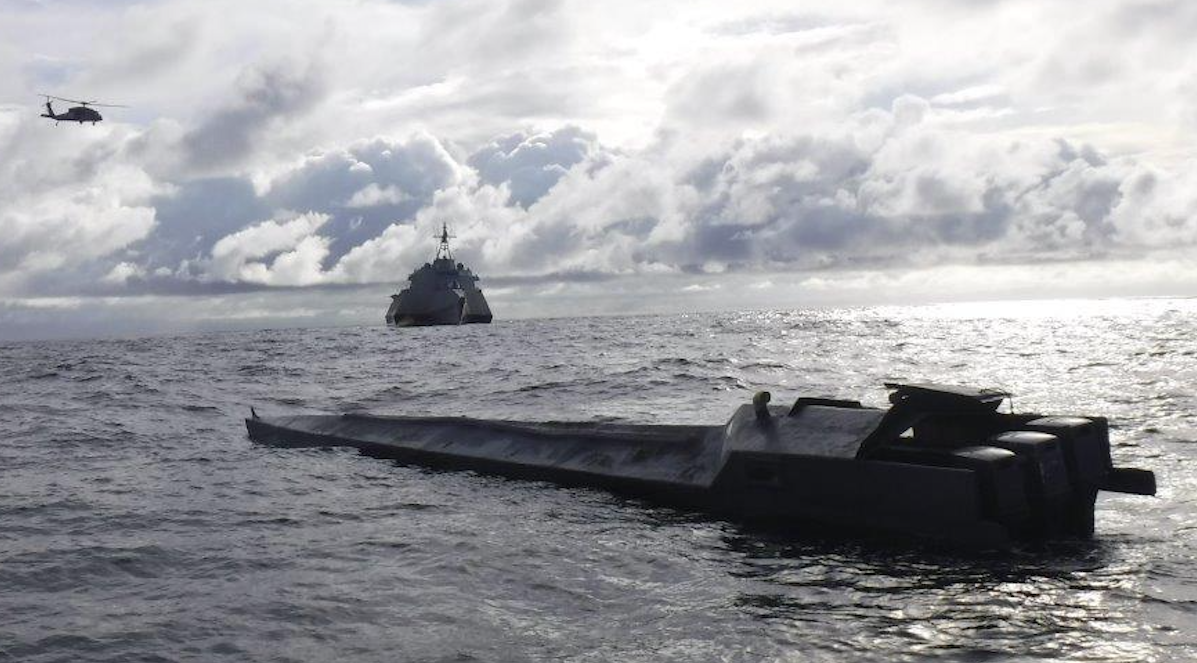
Operating in the Eastern Pacific with a Coast Guard law enforcement detachment (LEDET) aboard, the USS Gabrielle Giffords (LCS-10) interdicted a so-called narco submarine on Dec. 5.
Narco submarines are one way that drug traffickers smuggle cocaine from Colombia to markets in North America. Littoral Combat Ship Giffords is part of U.S. Southern Command’s enhanced counter-narcotics operations, the command announced.
The low-profile vessel (LPV) Giffords interdicted is typical of the ones found in that part of the world. Its slick lines, low freeboard barely showing above the water, and slender pencil-thin hull make it hard to see. This is a mass-produced design which has been seen many times before. In fact, it is at least the 19th of this exact model reported since 2017. It was built from roughly crafted fiberglass and is powered by three of the ubiquitous Yamaha Enduro 2-stroke outboard motors.
Its three crew are crammed into a tiny cockpit at the extreme rear of the craft. Running forward beneath the long deck is a narrow tunnel that serves as both a cargo hold and living space. The crew sleep there on the bales of cocaine. At either side of the tunnel are fuel tanks. About halfway to the bow, the tunnel opens out into the main cargo hold. And in front of that are more fuel tanks. The interior is generally cramped, smelly, unhygienic and claustrophobic. Yet the cartels find a ready supply of crew.
In this case, the three-person crew were arrested. And with them, around 4,806 pounds (2,810kg) of cocaine was seized. The cocaine comes in kilogram bricks which are then wrapped in plastic sacks to make bales. The value of this payload is over $100 million.
This time the payload, which equals 2.4 tons of cocaine, was much larger than has been typical for this type of narco submarine, according to recent reported seizure. This may be part of a wider trend where narco subs are entrusted with greater loads per trip. The one discovered by the Colombian Navy last month, on Nov. 5, could carry six metric tons. That design was more sophisticated, using 10 tons of batteries to propel it silently.
Possible reasons for the increasing payloads may include the impact of COVID-19 on other trafficking routes, such as commercial flights and shipping as well as the increased law enforcement efforts of SOUTHCOM, according to analysts. Since the beginning of April, SOUTHCOM has been carrying out enhanced counter-narcotics operations in the Eastern Pacific and the Caribbean. This has seen more warships, like Gabrielle Giffords, actively tasked with counter-narcotics missions with U.S. Coast Guard detachments embarked.
Aboard Gabrielle Giffords, the illegal drugs could be unloaded into the spacious mission bay. There they joined around 200 kg seized from a go-fast vessel (GFV) a few days before. Go-fasts are less sophisticated than the narco-subs and generally carry much less drugs.
Gabrielle Giffords completed a deployment to the Western Pacific in October before taking up the narco sub challenge in mid-October. Other LCS deployed on anti-drug missions at the time were USS Sioux City (LCS-11) and USS Detroit (LCS-7). SOUTHCOM continues to mount enhanced counter-narcotics operations employing warships in addition to Coast Guard cutters, aircraft and partner nation forces.





